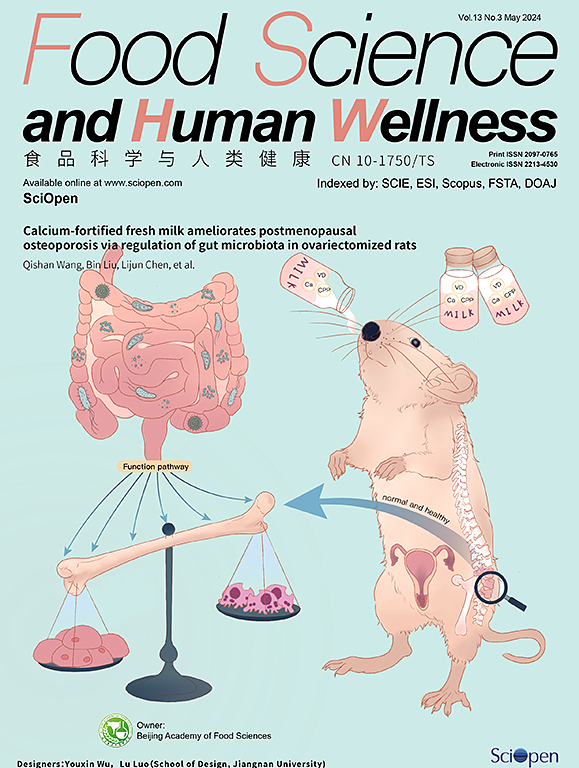A wheat germ-rich diet preserves bone homeostasis by regulating gut microbiota and plasma metabolites in aged rats
IF 7.4
1区 农林科学
Q1 FOOD SCIENCE & TECHNOLOGY
引用次数: 0
Abstract
Bone loss caused by ageing has become one of the leading health risk factors worldwide. Wheat germ (WG) is consists of high amounts of bioactive peptides, polyunsaturated fatty acids, and dietary fibre. Currently, WG has been proven to possess strong antioxidant and anti-inflammatory properties. We recently explored the beneficial effects and relevant mechanisms of a WG-rich diet (2.5 % and 5 % WG, m/m) on bone homeostasis in aged rats. Our results showed that 5 % WG supplementation for 12 months effectively attenuated ageing-induced microstructural damage and differentiation activity changes in the femur. The 5 % WG supplementation also significantly increased the levels of total antioxidant capacity (T-AOC), glutathione peroxidase (GSH-Px) (P < 0.01), and superoxide dismutase (SOD) (P < 0.05), and decreased inflammatory cytokine levels (tumor necrosis factor-α (TNF-α) and interleukin-6 (IL-6)) (P < 0.01). Furthermore, the WG-rich diet reshaped the composition of the gut microbiota, enhancing short-chain fatty acids (SCFAs)-producing microbes and reducing inflammation-related microbes. In addition, metabolomics analysis showed that 5 % WG supplementation improved plasma metabolites related to bone metabolism. Conclusively, our study purports long-term WG-rich diet may preserve bone homeostasis by regulating gut microbiota and plasma metabolites in aged rats.

富含小麦胚芽的饮食通过调节老年大鼠的肠道微生物群和血浆代谢物来保护骨稳态
衰老引起的骨质流失已成为世界范围内主要的健康风险因素之一。小麦胚芽(WG)由大量的生物活性肽、多不饱和脂肪酸和膳食纤维组成。目前,WG已被证明具有很强的抗氧化和抗炎特性。我们最近探讨了富含WG的饮食(2.5%和5% WG, m/m)对老年大鼠骨稳态的有益影响及其相关机制。我们的研究结果表明,补充5% WG 12个月有效地减弱了衰老引起的股骨微结构损伤和分化活性的变化。添加5% WG还显著提高了总抗氧化能力(T-AOC)、谷胱甘肽过氧化物酶(GSH-Px) (P <;0.01),超氧化物歧化酶(SOD) (P <;0.05),炎症细胞因子(肿瘤坏死因子-α (TNF-α)和白细胞介素-6 (IL-6))水平降低(P <;0.01)。此外,富含wg的饮食重塑了肠道微生物群的组成,增强了产生短链脂肪酸(SCFAs)的微生物,减少了与炎症相关的微生物。此外,代谢组学分析显示,添加5% WG可改善与骨代谢相关的血浆代谢物。最后,我们的研究表明,长期富含wg的饮食可能通过调节老年大鼠的肠道微生物群和血浆代谢物来维持骨稳态。
本文章由计算机程序翻译,如有差异,请以英文原文为准。
求助全文
约1分钟内获得全文
求助全文
来源期刊

Food Science and Human Wellness
Agricultural and Biological Sciences-Food Science
CiteScore
8.30
自引率
5.70%
发文量
80
审稿时长
28 days
期刊介绍:
Food Science and Human Wellness is an international peer-reviewed journal that provides a forum for the dissemination of the latest scientific results in food science, nutriology, immunology and cross-field research. Articles must present information that is novel, has high impact and interest, and is of high scientific quality. By their effort, it has been developed to promote the public awareness on diet, advocate healthy diet, reduce the harm caused by unreasonable dietary habit, and directs healthy food development for food industrial producers.
 求助内容:
求助内容: 应助结果提醒方式:
应助结果提醒方式:


